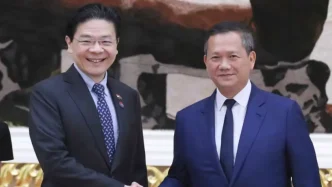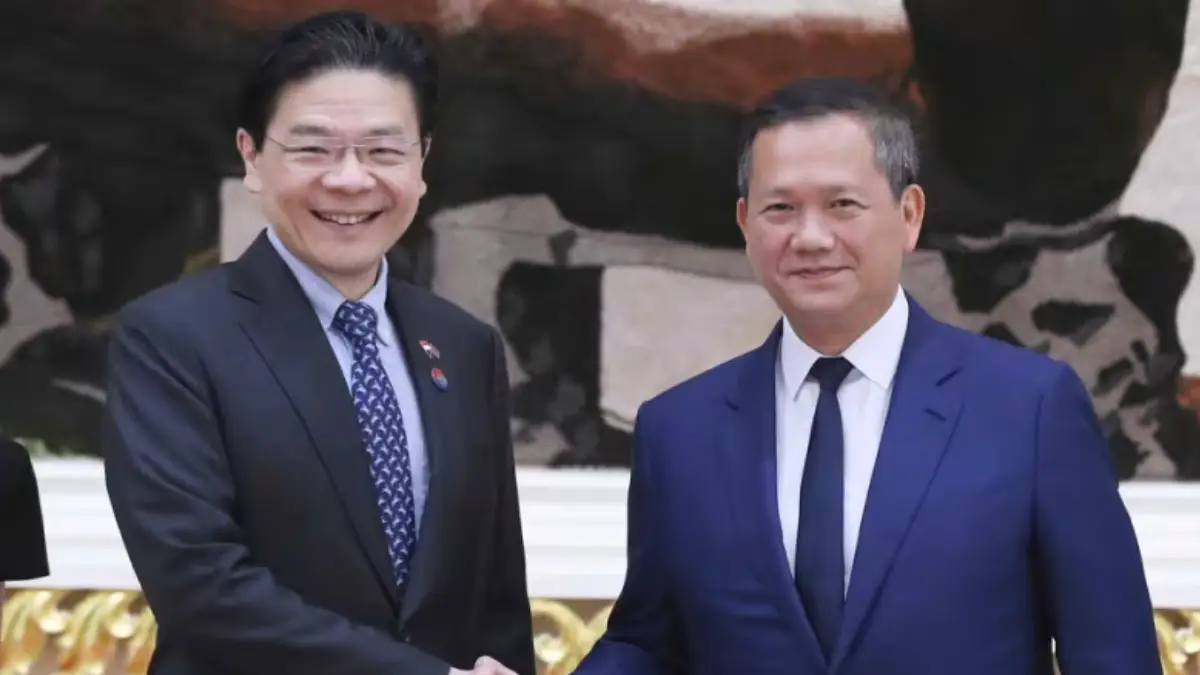As Singapore and Cambodia celebrate 60 years of diplomatic relations, leaders from both nations have pledged to deepen cooperation in renewable energy, carbon credits, and food trade, signaling a renewed commitment to regional stability and sustainable development within Asean.
A Milestone in Bilateral Relations
On July 2, 2025, Singapore’s Prime Minister Lawrence Wong made a significant stop in Phnom Penh as part of his introductory visits to Asean capitals. Hosted by his Cambodian counterpart, Prime Minister Hun Manet, at the Peace Palace, the visit underscored the enduring partnership between the two countries. In a toast speech during a luncheon, PM Wong reflected on the historical ties forged by Singapore’s founding leader, Lee Kuan Yew, and Cambodia’s King-Father Norodom Sihanouk, emphasizing a relationship built on “mutual respect, trust, and friendship.”
This foundation has propelled economic and diplomatic collaboration over the decades. Singapore stands as one of Cambodia’s largest investors and trading partners, with bilateral trade reaching $4.83 billion in 2024, a 7.1% increase from the previous year. As Cambodia’s third-largest foreign investor, Singapore’s economic footprint continues to grow, a point PM Wong highlighted during his discussions with Cambodian leaders, including King Norodom Sihamoni and Senate President Hun Sen.
Renewable Energy and Regional Connectivity
A key focus of the discussions between PM Wong and PM Manet was renewable energy, with both leaders recognizing its potential to create a greener, more interconnected Asean. A flagship initiative in this area is Singapore’s plan to import 1 gigawatt (GW) of low-carbon electricity from Cambodia, a project seen as a cornerstone for the ambitious Asean Power Grid. This grid aims to link the electricity networks of member states by 2045, facilitating cross-border power trading and reducing reliance on fossil fuels.
Progress is already underway, with Singapore’s Keppel signing a 2023 agreement with Cambodia’s Royal Group Power for the long-term import of 1 GW of low-carbon electricity. PM Wong described this as a “key building block” for regional energy integration, a step toward shared sustainability goals. Such initiatives not only address climate challenges but also strengthen economic ties, positioning both nations as leaders in Asean’s green transition.
Carbon Credits and Rural Development
Beyond energy, the two countries are advancing cooperation on high-quality carbon credits. Building on a prior memorandum of understanding, they are finalizing an implementation agreement to mobilize financing for clean-energy projects. According to PM Wong, this collaboration will “uplift rural communities and improve livelihoods” while supporting both nations’ net-zero ambitions. By investing in carbon offset programs, Singapore and Cambodia aim to balance economic growth with environmental responsibility, offering a model for other Asean countries to emulate.
This partnership reflects a broader trend in the region, where carbon markets are increasingly seen as a tool for sustainable development. If successful, the agreement could pave the way for similar bilateral arrangements, reinforcing Asean’s role in global climate action.
Food Security and Agricultural Trade
Food security emerged as another priority during the talks, with Singapore seeking to diversify its food import sources and Cambodia positioning itself as a key agricultural exporter. Given that Singapore imports nearly all its food, closer collaboration in this sector promises mutual benefits. “We are keen to diversify our sources of food imports, so closer collaboration in this area will be mutually beneficial for both our countries,” PM Wong noted during his address.
Cambodia’s agricultural sector, known for rice and other staples, stands to gain from access to Singapore’s market, while Singapore benefits from a reliable supply chain in a geopolitically stable partner. This agreement could serve as a buffer against global supply chain disruptions, a growing concern amid rising food prices and climate-related challenges.
Asean Unity and Regional Stability
Amid an uncertain global environment, both leaders reaffirmed their commitment to Asean centrality and unity. PM Wong stressed the importance of maintaining open dialogue and resolving differences peacefully, a sentiment echoed in his discussions about recent tensions at the Cambodia-Thailand border. While specifics of the border issue were not disclosed, Singapore’s Ministry of Foreign Affairs noted that PM Wong encouraged both sides to de-escalate tensions and seek an amicable solution in line with international law and Asean solidarity.
“In this uncertain global environment, it is more important than ever for Asean to stay cohesive,” PM Wong emphasized. His call for unity underscores the broader challenges facing the region, from territorial disputes to economic disparities, which require collective action to preserve stability. Singapore and Cambodia’s shared vision for a united Asean could serve as a counterbalance to external pressures, ensuring the bloc remains relevant on the global stage.
Human Capital and Development
Human development remains a cornerstone of the partnership, with nearly 19,000 Cambodian officials having benefited from training under the Singapore Cooperation Programme (SCP). Covering areas such as public health, digital governance, and public administration, much of this training occurs at the Cambodia-Singapore Cooperation Centre in Phnom Penh. Established under the Initiative for Asean Integration during Singapore’s chairmanship in 2000, the center is one of three such facilities in the region, alongside those in Laos and Vietnam.
PM Wong highlighted the transformative impact of these programs, which equip Cambodian officials with skills to support the country’s development goals. Under PM Manet’s leadership, Cambodia has set an ambitious target to become a high-income nation by 2050, a journey Singapore has pledged to support. “Singapore will continue to walk alongside Cambodia in this development journey,” PM Wong affirmed, signaling a long-term commitment to capacity building.
Cambodia’s Remarkable Progress
Reflecting on Cambodia’s trajectory, PM Wong praised the nation’s transformation from a post-conflict society to a rapidly developing economy over the past six decades. He credited PM Manet’s leadership for charting a forward-looking strategy, expressing confidence that the bilateral partnership would continue to deepen. “With Prime Minister Manet’s support and leadership, we will continue to expand our cooperation for win-win outcomes,” he said, highlighting the potential for shared prosperity.
Cambodia’s progress serves as an inspiration within Asean, demonstrating resilience and ambition. For Singapore, supporting this growth aligns with its broader foreign policy of fostering stability and development in Southeast Asia, a region critical to its own economic and security interests.
Looking Ahead: Challenges and Opportunities
As Singapore and Cambodia mark this milestone, their partnership faces both opportunities and challenges. The renewable energy and carbon credit initiatives, while promising, require significant investment and coordination to achieve their full potential. Similarly, resolving regional tensions, such as those at the Cambodia-Thailand border, will test Asean’s ability to mediate disputes and uphold its principles of non-interference and consensus.
Yet, the shared commitment to dialogue and cooperation offers hope. PM Wong’s visit, though brief, has laid the groundwork for deeper collaboration, from energy grids to food security. As he concluded in a social media post, “It is in our collective interest to work together to preserve peace, strengthen regional stability, and deepen Asean integration.”
With global uncertainties looming, the strengthened ties between Singapore and Cambodia stand as a testament to the power of diplomacy and mutual respect. How these agreements translate into tangible outcomes—whether in cleaner energy, improved livelihoods, or regional harmony—remains a question for the years ahead.
















